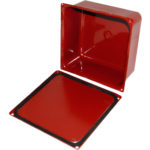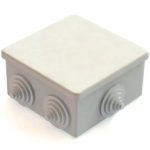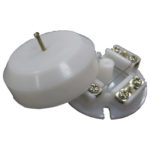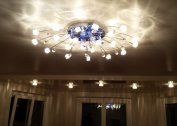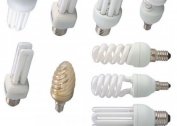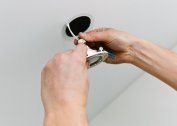Junction boxes on the wall are electrical installations designed to protect communication electrical networks at their junctions from harmful environmental factors. Devices are mounted almost everywhere where cables or electrical wiring with a voltage of no more than 1000 V are switched.
Purpose and use
There are many varieties of junction boxes. They may vary in shape, size, material of manufacture. However, they have one task - to hide the contents from the destructive environmental factors. Each model is equipped with a cover.
An electrical installation is used not only at home, but also in industry for fastening and branching wires when installing hidden wiring. There is a practice of installing such structures when conducting open wiring, but the appearance at the same time leaves much to be desired.
The main tasks facing the device:
- Protection against mechanical, thermal and chemical effects.
- Aesthetic design of electrical wiring at the junction of conductive conductors.
Junction boxes are most often used for lighting and power electric mains of direct and alternating current with a voltage of not more than 660 V and low-current wiring. You can mount structures not only indoors, but also on the street.
Type classification
Switching designs are divided into several types depending on the purpose.
- For connecting and protecting joints of cable lines with a voltage of not more than 1 kW, for example, WWTP, KRP, KVP, U997M, U994, U197, etc. They can also be installed with the UHL system.
- A box with a standard size (100 * 100 * 50 mm) is used for open and hidden wiring at home. For example, KO100, KTO100, KU100, KT100, KS100, KM100.
- Branch structures designed to store and protect the connection points of wireline broadcasting UK2R and UK2P.
- U997M
- Outdoor wiring box
- UK2-R
Also, by design type, they are divided into lingering and cable for overhead lines and junction boxes to the busbar trunking (SHRA).
Protection class
Among the main characteristics of junction boxes is the protection class according to GOST No. 1425496. It looks like IPXX, where the last two combinations are a digital designation. The first digit indicates resistance to dust, and the second moisture.
| The code | Dust protection | Moisture protection |
| 0 | No protection provided | No protection provided |
| 1 | Excluded the possibility of penetration of particles larger than 50 mm | The design is protected against vertically falling drops, for example, rain, condensation. |
| 2 | Particle sizes larger than 12 mm are excluded under the cover of the box | The box is protected against moisture ingress at an angle of 15 degrees |
| 3 | Particles larger than 2.5 mm are not allowed to enter. | The device is protected from dripping, the angle of incidence of which is not more than 60 degrees |
| 4 | Particle sizes larger than 1 mm are prevented. | Full protection of the box against splashes and drops |
| 5 | The unit is protected against dust deposits. | Complete protection against water jets |
| 6 | There is no likelihood of dust falling under the cover of the structure | High pressure water jet protection |
| 7 | Protection of the structure when completely immersed in a humid environment to a depth of not more than 1 meter (short-term lowering in a humid environment) | |
| 8 | The design is completely tight and can work under water |
Dust and moisture proof constructions have a greater weight and dimensions. The protection class is also reflected in the cost. The larger the numbers, the more reliable the protection, the higher the price.
The choice for home wiring
Distribution box for concealed wiring and open is selected depending on the type of trunk installed.
- For external wires, it is required to use overhead branch structures (they are mounted directly on the wall surface).
- If the wiring is hidden, built-in models designed for wall mounting are required.
For use at home, it is not at all necessary to purchase modifications with a high class of protection. A completely sealed construction may be required if it is installed near a house on the street.
Most modern models are equipped with special terminals, which greatly simplify the installation process. There are also boxes equipped with a fuse, which, in the event of a short circuit, in an emergency, disconnects the power supply. An additional advantage is that the equipment with terminals and clamps does not affect the cost slightly.
When choosing, you need to analyze the material of which the wall is made, since the method of fastening will depend on this. Boxes are mounted on a mortar in a concrete wall or brick, and special fasteners are provided for walls made of drywall.
Better give preference to trusted brands. The cost is usually higher, but the build quality is more reliable.
Branch box installation
During the installation of the electrical installation, it is better to follow all the public and unwritten rules. Wire lines, as a rule, run at heights or under the ceiling, therefore, the boxes are mounted in the same place so as not to waste extra meters of expensive cable. However, it is important to ensure free access to the structure in case of emergency or emergency situations.
If the wiring is stretched in the space between the stretch ceiling and the base of the wall, the boxes must be placed below the level of the false ceiling. The ends of the conductive wires must be brought down. This can cause its difficulties, but in the future, during repair and maintenance, the tasks set will be much easier to fulfill.
After installation, it is important that the integrity of the structure is not compromised. The lid should close tightly and securely, it is not necessary to clog the internal space heavily with wires, it is better to install a new box of large sizes or another one next.
Modernization, maintenance and repair of wiring is impossible without opening the junction boxes, therefore, when laying the wiring, it is important to draw up the correct diagram, which indicates the number and location of electrical structures, how many lines are included in them. First of all, this applies to devices designed for hidden wiring.

